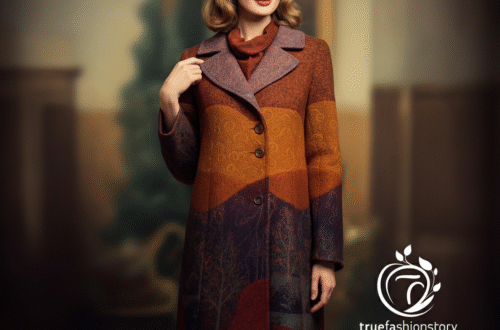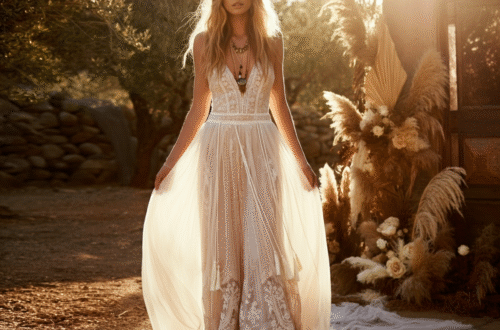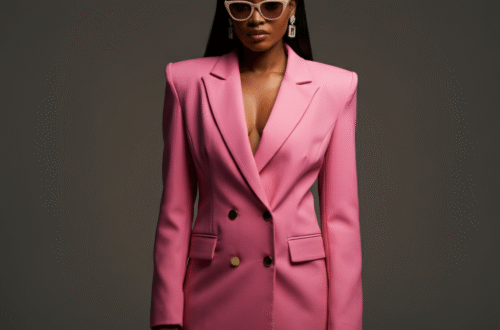Burlesque fashion is more than just clothing; it’s a celebration of glamour, confidence, and theatrical art. This unique style blends vintage elegance with dazzling showmanship, creating looks that are both powerful and playful. From the elaborate corsets of the Victorian era to the sparkling rhinestones of modern performers, burlesque style has a rich history that continues to influence designers and fashion lovers today. It’s a world filled with feathers, lace, and a whole lot of sparkle.
This guide will take you on a journey through the captivating world of burlesque fashion. We will explore its historical roots, identify its most iconic elements, and show you how to incorporate this glamorous style into your own wardrobe. Whether you are a performer, a vintage enthusiast, or simply someone who appreciates bold and beautiful clothing, there is something in burlesque for you.
Key Takeaways
- Burlesque fashion evolved from Victorian stage costumes and has been shaped by iconic performers and historical eras.
- Core elements include corsets, stockings, feathers, gloves, and sparkling embellishments like rhinestones and sequins.
- Modern burlesque has been revived by performers like Dita Von Teese, who brought back classic Hollywood glamour.
- You can easily incorporate burlesque elements into everyday wear with accessories, specific garments, or a vintage-inspired aesthetic.
- The style is all about celebrating individuality, confidence, and self-expression through theatrical and glamorous clothing.
A Glimpse into the History of Burlesque
The story of burlesque fashion begins in the mid-19th century. Originally, “burlesque” was a form of satirical theatre that poked fun at high society, opera, and classical plays. The costumes were an essential part of the comedy. Performers would wear exaggerated versions of upper-class clothing, often with a humorous or slightly risqué twist. These early shows were more about parody than seduction, but they laid the groundwork for the glamorous style we know today. The costumes were designed to be seen from the back of a large theatre, so they were bold, colorful, and eye-catching.
As burlesque evolved through the late Victorian and early 20th centuries, so did its fashion. The focus shifted from pure satire to a more glamorous and teasing performance art. This era saw the rise of the “striptease,” though it was far from what one might imagine today. It was a slow, artful removal of layers, like gloves or a stole, designed to be elegant and theatrical. The clothing itself became more elaborate, with intricate beadwork, luxurious fabrics like silk and satin, and of course, the iconic corset, which created the coveted hourglass silhouette.
The Golden Age of Glamour
The 1930s to the 1950s are often called the “Golden Age of Burlesque.” During this time, performers like Gypsy Rose Lee and Lili St. Cyr became household names. Their costumes were masterpieces of design, often costing thousands of dollars. These outfits featured sprawling feather fans, gowns dripping with sequins, and perfectly tailored lingerie. Fashion from this era was heavily influenced by Hollywood glamour. The look was polished, sophisticated, and utterly captivating. Each costume piece was designed for maximum impact on stage, meant to catch the light and the audience’s eye with every movement. This period solidified the core aesthetic of burlesque fashion as one of ultimate opulence and showmanship.
The Modern Revival
After a decline in popularity in the mid-20th century, burlesque experienced a massive resurgence in the 1990s, often called the “neo-burlesque” movement. This revival was led by performers like Dita Von Teese, who brought back the classic glamour of the Golden Age but with a modern, empowered twist. Modern burlesque fashion honors its vintage roots while embracing a wider range of styles, from classic pin-up and rockabilly to punk and avant-garde. Today’s performers often design their own costumes, pouring their creativity into every rhinestone and feather. This new wave has made burlesque fashion more accessible and celebrated than ever before, influencing mainstream fashion and pop culture. For more on trends in pop culture, you can check out the truefashionstory.
The Essential Elements of Burlesque Fashion
Certain key pieces define the look of burlesque. These elements can be worn as part of a full stage costume or used as statement pieces to add a touch of glamour to an everyday outfit.
The Iconic Corset
The corset is perhaps the most recognizable garment in burlesque fashion. It has been a staple for centuries, designed to cinch the waist and create a dramatic hourglass figure. In burlesque, corsets are not just undergarments; they are often the centerpiece of an outfit. They come in various styles:
- Overbust Corsets: Worn over the bust, acting as a top. They are often heavily embellished with lace, beading, or sequins.
- Underbust Corsets: These sit just under the bust and are worn over a blouse or dress to define the waistline. They are a great way to add a burlesque touch to a more conventional outfit.
Modern corsets are made with more comfortable materials and boning (often plastic or spiral steel) than their historical counterparts, making them more wearable for extended periods.
Stockings and Garter Belts
No burlesque look is complete without stockings. Seamed stockings, in particular, scream vintage glamour, drawing a clean line up the back of the leg. They are held up by a garter belt (or suspender belt), another key element of the style. Garter belts themselves can be simple and functional or ornate pieces decorated with lace and bows. This combination is fundamental to the classic burlesque silhouette and adds a layer of intricate detail to the overall look. Fishnet stockings are also a popular choice, offering a slightly edgier, more modern vibe.
Feathers, Feathers Everywhere
Feathers bring movement, drama, and luxury to burlesque costumes. They are used in countless ways, from large, dramatic feather fans used in teasing reveals to boas draped elegantly around the shoulders. Feathers can also be used as trim on clothing, headdresses, and accessories. Ostrich and marabou feathers are particularly popular for their soft, flowing texture. A feather boa is one of the easiest ways to inject instant burlesque glamour into any look, whether you’re on stage or just heading to a themed party.
Gloves: The Finishing Touch
Long, elegant gloves, often reaching past the elbow, are a hallmark of classic burlesque. Known as opera gloves, they add a touch of sophistication and are a key part of the traditional striptease. The slow, deliberate removal of a glove is a classic burlesque move. Gloves can be made from satin, lace, or velvet and serve as the perfect finishing touch to a polished, vintage-inspired ensemble. They are a simple accessory that carries a great deal of stylistic weight.
Rhinestones, Sequins, and Sparkle
Burlesque is all about catching the light. Rhinestones, sequins, crystals, and beads are used generously to ensure every costume dazzles under the stage lights. Performers often spend countless hours “stoning” their own costumes, painstakingly gluing each crystal by hand. This dedication to sparkle is what gives burlesque costumes their magical, eye-catching quality. From rhinestone-encrusted bras to fully sequined gowns, this element of high-wattage shine is non-negotiable in the world of burlesque fashion.
Burlesque vs. Pin-Up: Understanding the Difference
While often linked, burlesque and pin-up are two distinct styles. Understanding their differences can help you better define your own vintage-inspired look.
|
Feature |
Burlesque Fashion |
Pin-Up Style |
|---|---|---|
|
Primary Focus |
Theatrical performance, glamour, and opulence. |
Everyday wear, playful and wholesome sexiness. |
|
Key Garments |
Corsets, elaborate lingerie, gowns, feather boas. |
High-waisted shorts, wiggle dresses, pencil skirts, cardigans. |
|
Embellishments |
Heavy use of rhinestones, sequins, feathers, and beading. |
Minimal embellishments; focus is on prints like polka dots, cherries, and florals. |
|
Context |
Primarily for stage, themed events, or fantasy wear. |
Daytime and casual wear inspired by the 1940s and 1950s. |
|
Overall Vibe |
Dramatic, luxurious, and show-stopping. |
Sweet, sassy, and retro-chic. |
In short, think of burlesque as the extravagant costume you wear for a performance and pin-up as the charming dress you wear to a picnic. While they share a common appreciation for vintage silhouettes, their purpose and execution are quite different.
How to Incorporate Burlesque Style into Your Wardrobe
You don’t have to be a stage performer to enjoy the beauty of burlesque fashion. Here are a few simple ways to add a touch of its glamour to your everyday life.
Start with Accessories
Accessories are the easiest way to experiment with the style. Try adding a pair of satin gloves to a formal dress for an evening event. A simple black fascinator with a bit of netting or a few feathers can elevate your look for a party. Even a vintage-style brooch with some sparkle can add a hint of burlesque elegance to a blazer or coat.
Embrace the Silhouette
Focus on creating an hourglass shape. High-waisted pencil skirts, wide belts that cinch your waist, and structured tops can all help you achieve this classic silhouette. A well-fitted wiggle dress is a perfect example of a garment that channels vintage glamour without being a full costume. These pieces celebrate your curves in a way that is central to the burlesque aesthetic.
Wear a “Tame” Corset
You can wear a less dramatic underbust corset over a simple white button-down shirt or a fitted black dress. This instantly adds a theatrical, waist-defining element to your outfit that is both bold and stylish. Choose one in a solid color like black or red for maximum versatility. This is a powerful statement piece that directly borrows from historical burlesque fashion.
Play with Fabrics and Textures
Incorporate luxurious fabrics like satin, velvet, and lace into your wardrobe. A velvet blazer, a satin camisole peeking out from under a jacket, or a lace-trimmed skirt can all bring a subtle touch of burlesque opulence to your daily style. These textures add depth and a sense of luxury to any outfit, making you feel just a little more glamorous.
Conclusion
Burlesque fashion is a rich and vibrant style that is so much more than its on-stage persona. It is a powerful form of self-expression, a nod to historical glamour, and a celebration of individuality. Rooted in theatricality, it empowers the wearer to feel confident, elegant, and unapologetically bold. Whether you are drawn to the structured beauty of a corset, the playful sway of a feather boa, or the dazzling shine of rhinestones, there are countless ways to make this style your own. By understanding its key elements and history, you can begin to weave the magic and allure of burlesque fashion into your own life, one glamorous piece at a time.
Frequently Asked Questions (FAQ)
1. What is the difference between burlesque and lingerie?
Lingerie is typically designed as functional or intimate undergarments. Burlesque fashion, while it often includes lingerie-style pieces, is designed as costume for performance. Burlesque garments are meant to be seen and are usually far more embellished, theatrical, and structured than everyday lingerie.
2. Who are some famous burlesque fashion icons?
Historic icons include Gypsy Rose Lee and Lili St. Cyr, who defined the Golden Age of burlesque. The most famous modern icon is Dita Von Teese, who is largely credited with reviving the art form and its classic, glamorous aesthetic.
3. Can I wear burlesque fashion in public?
Absolutely! While a full stage costume might be reserved for a special event, you can easily incorporate elements of burlesque fashion into your everyday wardrobe. A corset-style belt, a pencil skirt, opera gloves for a formal occasion, or a touch of lace and satin are all great ways to rock the style.
4. What materials are common in burlesque fashion?
Common materials include satin, silk, velvet, lace, and tulle. Embellishments are also key, so you will see a lot of rhinestones, sequins, beads, and feathers, particularly ostrich and marabou.
5. How do I start building a burlesque-inspired wardrobe?
Start small. Begin with accessories like vintage-style jewelry or a fascinator. Try a key garment like a high-waisted pencil skirt or a satin blouse. From there, you can experiment with more daring pieces like an underbust corset or a feather accessory. The goal is to find what makes you feel confident and fabulous.





